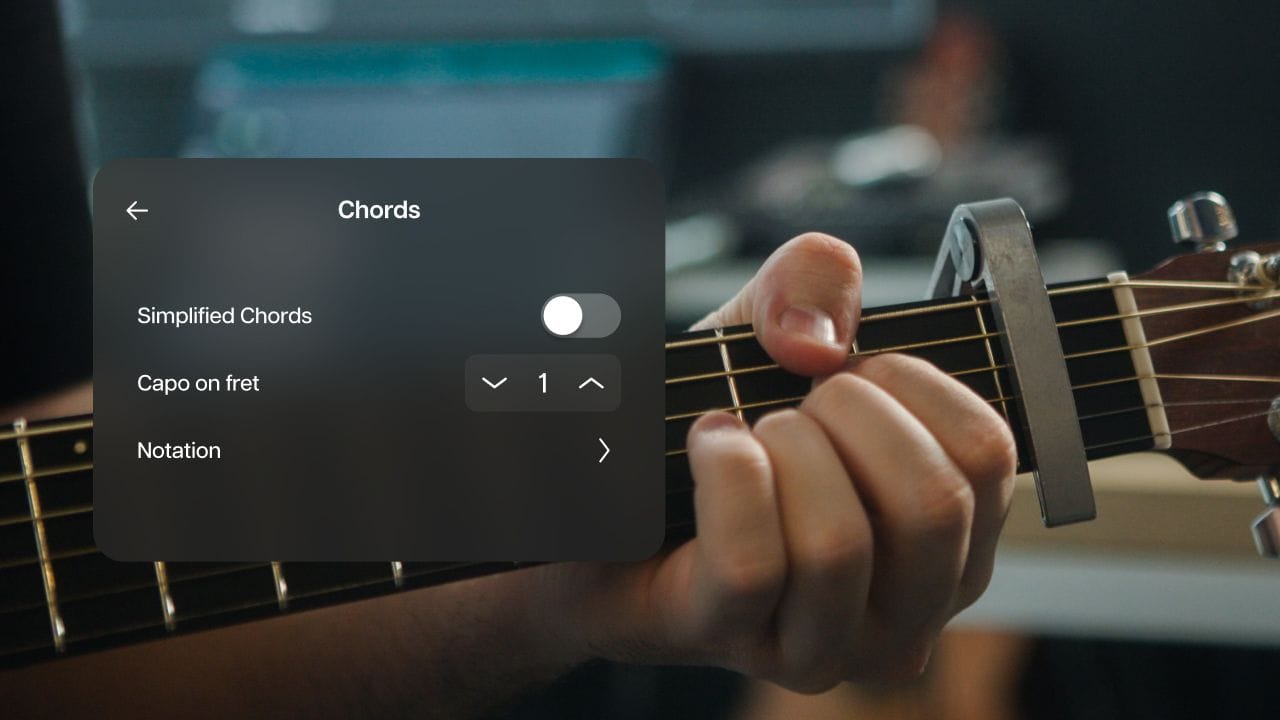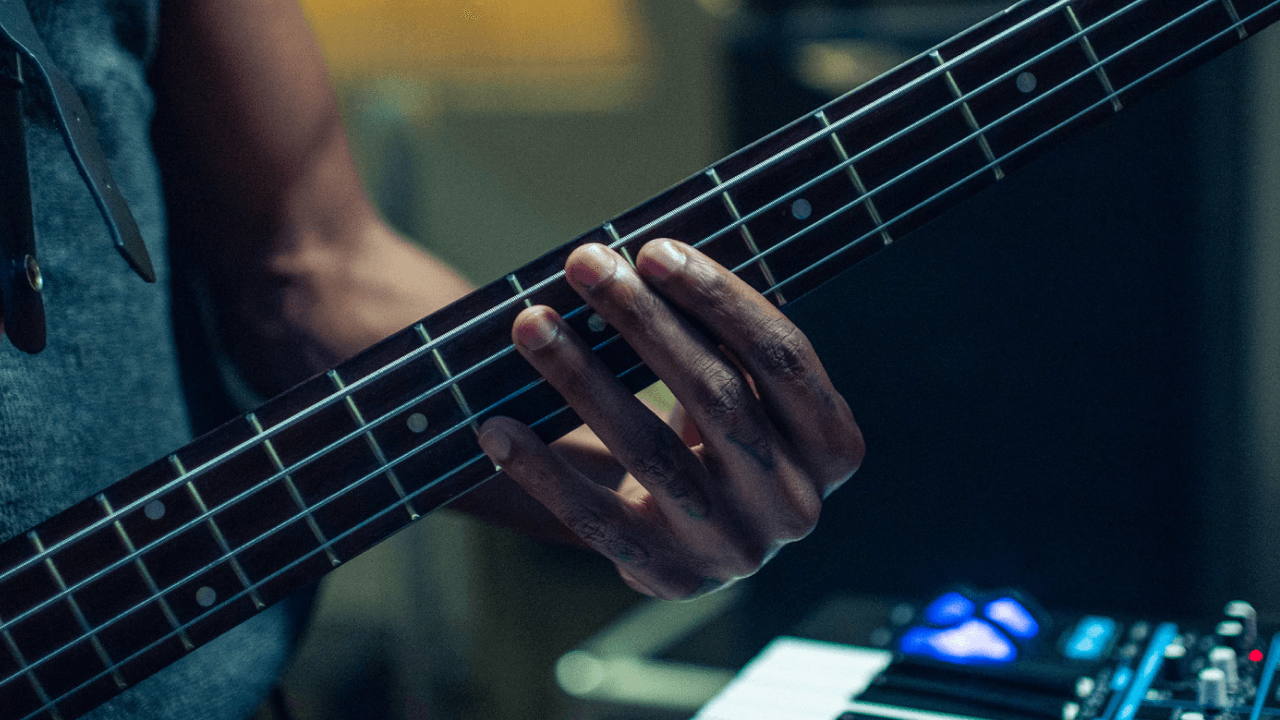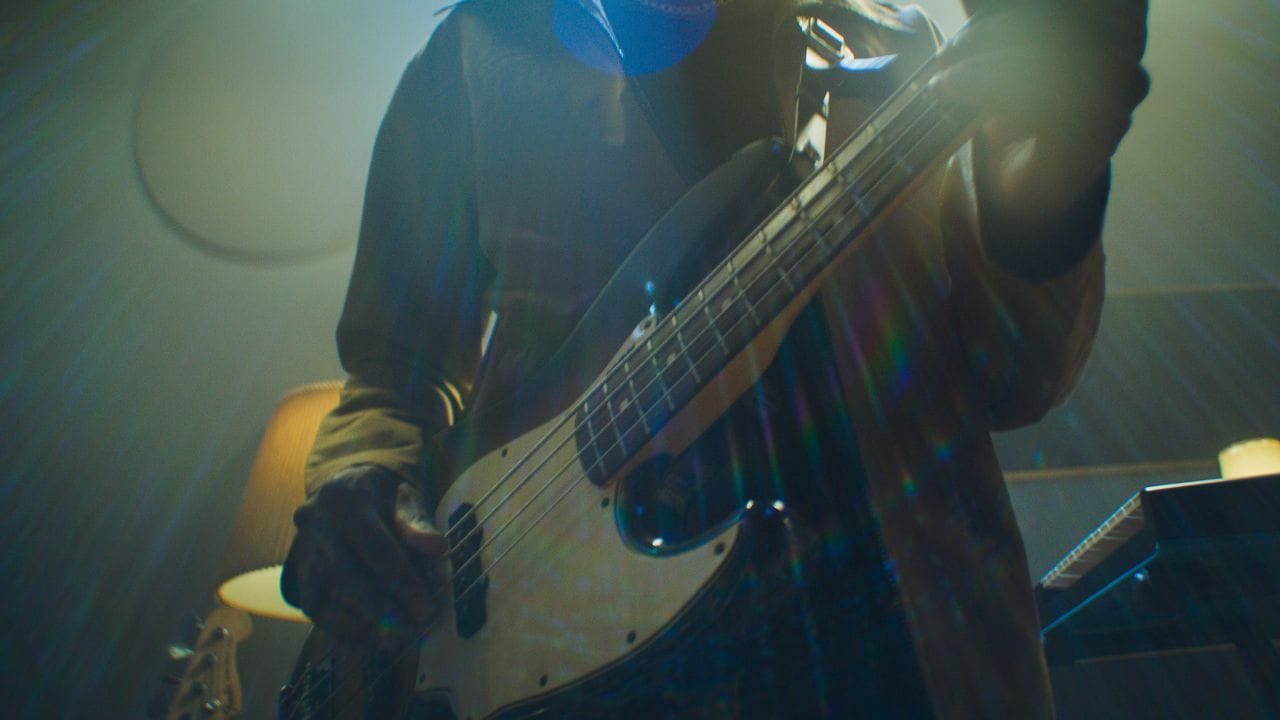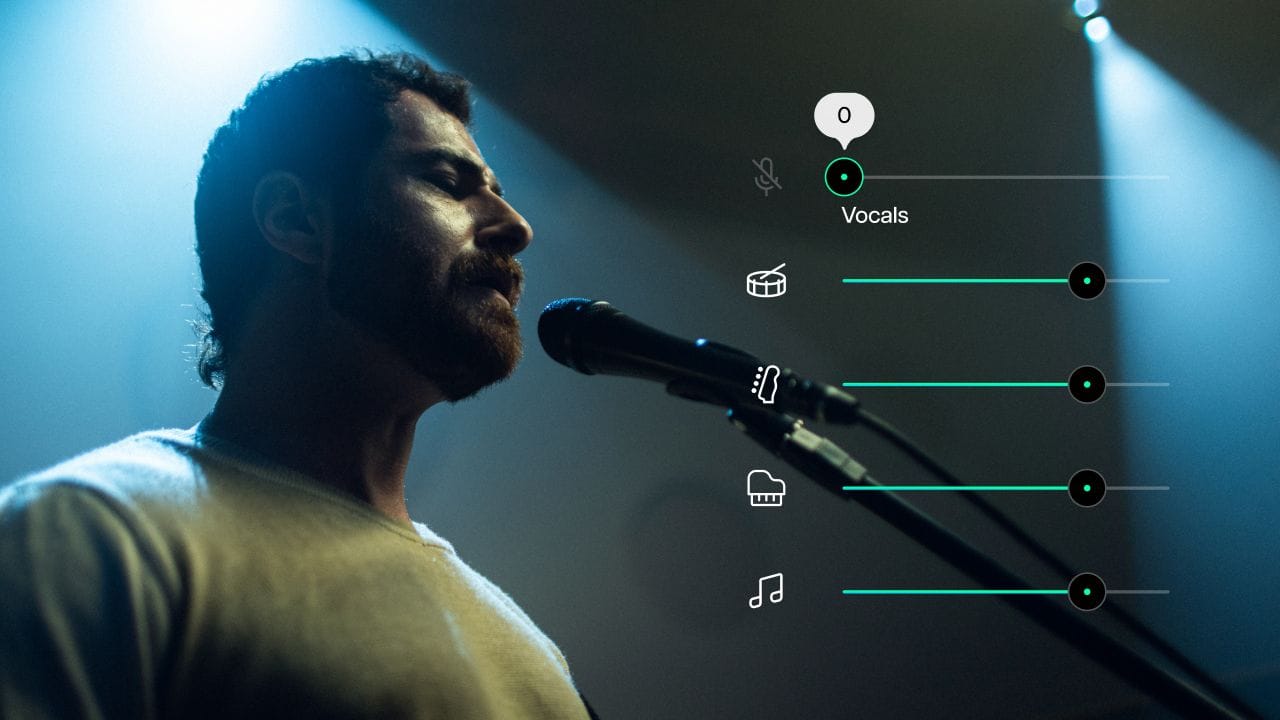Imagine you’ve learned a song’s entire chord progression, but the original key doesn’t fit your voice—and you want to sing. Re-learning the chord progression is probably a chore you’d like to avoid, especially if the appropriate key involves more complex chords. A guitar capo is specifically designed to address this type of issue.
Serving as a movable nut of the guitar, this tool is a real game-changer for guitarists. Here, you’ll find out details about how it works, what it does, how to pick one, and much more. Keep reading!
What is a guitar capo? What does a guitar capo do?
A guitar capo is a small device that clips onto a guitar’s neck to raise the pitch of the strings, changing the instrument’s key. You can place it on any fret to play familiar chord shapes in different keys.
Capos are designed to apply even pressure across all strings, and you can think of them as a way to move where you start on the fretboard. When you put the capo higher on the neck of the guitar, it makes the playable part shorter—and the sound higher.
A capo can also help you avoid barre chords, which can be challenging for some guitar players. By placing the capo on a higher fret, you can use simpler open chord shapes that are easier to play. For example, if you place the capo on the 6th fret, you can use familiar shapes like the C, G, and D chords to play in a higher key without needing to use barre chords. This technique makes playing more comfortable and allows you to explore different tonal colors and dynamics without the added difficulty of barre chord shapes.
The science behind capo placement on the fretboard
Understanding how the capo position works with the fretboard and note names is very important. Here’s how it works: each fret on the guitar adds a half step.
For instance, if you put a capo on the first fret:
- An open E string will sound like an F;
- An open A string will sound like a Bb.
Let’s say a song starts in the key of C. Putting the capo on the first fret changes it to C#; moving it to the second fret changes it to D, and so on.
Another example is playing a G chord with a capo on the second fret. In this case, you are actually playing an A chord. The relationship between the chords stays the same, but the whole progression goes up by two half steps.
Guitar capos vs. guitar clamps
Guitar capos are specifically used to clamp down on the strings of a guitar, which is why some people refer to them as guitar clamps.
However, the term “guitar clamp” can also refer to other things, like a tool used in guitar repair and maintenance. In this case, a guitar clamp serves to hold parts of the guitar securely while work is being done (such as when glue needs to be set).
Different types of guitar capos explained
These accessories come in various forms, each designed to cater to different preferences and requirements. The best choice depends on the guitarist’s specific needs, be they quick onstage key changes, experimenting with creative tunings, or requiring precise pressure control.
Next, you can check out the main types of guitar capos.
Trigger capo
A highly popular choice, this capo features a spring-loaded mechanism, allowing for easy, one-handed operation. It’s perfect for guitarists requiring quick key changes. While it provides a strong grip and comes in various designs, it can be somewhat bulky and potentially affect tuning if applied too tightly.
Toggle capo
A simple, lightweight option that uses an adjustable strap to secure. Its advantages include being inexpensive, easy to carry, and store. On the downside, it might not offer as even of pressure as other capos and could be less durable.
Partial capo
It is unique in covering only some strings, allowing players to explore alternate tunings without altering the guitar’s base tuning. It’s excellent for experimenting with new chord voicings but has a more niche application and requires some understanding of the tunings it facilitates.
Shubb capo
This lever-style capo allows for precise tension adjustments via a screw mechanism. It’s valued for its durability and minimal effect on tuning; however, it is slightly more costly and takes longer to adjust than others.
Roller capo
Distinguished by its rolling mechanism, this capo can be moved up and down the neck without needing to be removed entirely. It enables quick fret changes with minimal tuning interference. While innovative, it tends to be less commonly found and may be pricier.
History and evolution of guitar capos
The history of the guitar capo shows how creative musicians can be. Starting as simple tools, capos changed into sophisticated, helpful devices that allow for more options when playing the guitar.
Who invented guitar capos?
Guitar capos evolved over centuries, so their invention can’t really be attributed to a single person. The earliest forms date back to the 17th century, with musicians using different tools to clamp strings. Yet, James Ashborn, a guitar manufacturer in the US, patented the standalone guitar capo in 1850.
Ashborn’s design featured a wooden cylinder and brass thumbscrew to apply pressure to the strings. While it wasn’t exactly like today’s capos, this was a significant step in the evolution of the accessory.

Modern innovations in capo design
The evolution of capo design has transformed how guitarists interact with this essential tool. No longer just simple clamps, modern capos have been engineered for precision, ease of use, and minimal impact on guitar strings.
One of the most significant advancements is the development of adjustable-tension models. These allow players to fine-tune the pressure applied to the strings, ensuring accurate tuning while minimizing unwanted buzzing or muting.
Additionally, contemporary capos are crafted with ergonomics in mind, featuring designs that are comfortable to handle and easy to operate. Constructed from durable, high-quality materials, today’s capos are built to withstand the rigors of regular use, catering to the diverse needs of modern guitarists.
How to choose the right capo for your guitar
Selecting the right capo is essential for enhancing your playing experience. With a wide range of options available, it’s important to consider a few key factors that align with your guitar type, playing style, and personal preferences.
Factors to consider when choosing a capo
The shape and size of your guitar neck play a significant role in how well a capo fits. Measure the width and curvature of your neck to ensure a snug fit.
Additionally, if you frequently switch between different keys or songs, a quick-release capo, such as a trigger one, might be your best bet. For those who tend to play in one key, a screw-on or strap capo offers greater stability and precision.
Capo materials and their impact on tone
The materials used in a capo can subtly influence your guitar’s sound. Different materials interact with the strings uniquely, affecting tone brightness, warmth, and sustain.
For example, metal capos made from aluminum or brass often produce a brighter, clearer tone, making them ideal for genres like folk or bluegrass. In contrast, wooden capos are popular among classical guitarists for their ability to add warmth and richness to the sound.
When choosing a capo, consider your guitar’s natural tone and the style of music you play. Don’t hesitate to experiment with different materials to discover the one that best complements your sound.
Recommendations for acoustic and electric guitarists
While the search for capos focuses more heavily on acoustic guitars, they can also be used on electric guitars. In this case, it’s best to opt for a capo that is sleek and won’t interfere with your pickups. Electric guitarists tend to favor lightweight, low-profile capos, and many prefer trigger capos for their ease of use when switching songs.
On the other hand, acoustic guitarists can benefit more from capos that enhance tone and minimize string buzz. Those with adjustable tension and soft padding are excellent choices. Make sure to select capos specifically designed for the wider fretboards of acoustic guitars.
How to best use a guitar capo
Using a guitar capo might seem intimidating at first, but it’s actually quite simple and will become second nature with a little practice. The key is understanding where to place it and how to apply even pressure across the strings.
Proper capo placement and adjustment
Correctly positioning and adjusting your capo is essential for achieving clear, in-tune notes. Follow these steps to ensure optimal performance:
- Choose the desired fret: Decide based on the key you want to play in. This allows you to transpose songs easily without going for different chord shapes;
- Position the capo just behind the fret, not on top of it: This positioning ensures that the strings are pressed down firmly without creating unwanted buzzing or muffled sounds;
- Apply even pressure: Secure the capo so that it applies consistent pressure across all strings. Whether you’re using a trigger, screw-on, or strap capo, make sure each string rings out clearly by adjusting the tension as needed;
- Check your tuning: Play each string individually to check for accurate tuning. Sometimes, adding a capo can slightly alter string tension, so make minor tuning adjustments if necessary to maintain perfect pitch.
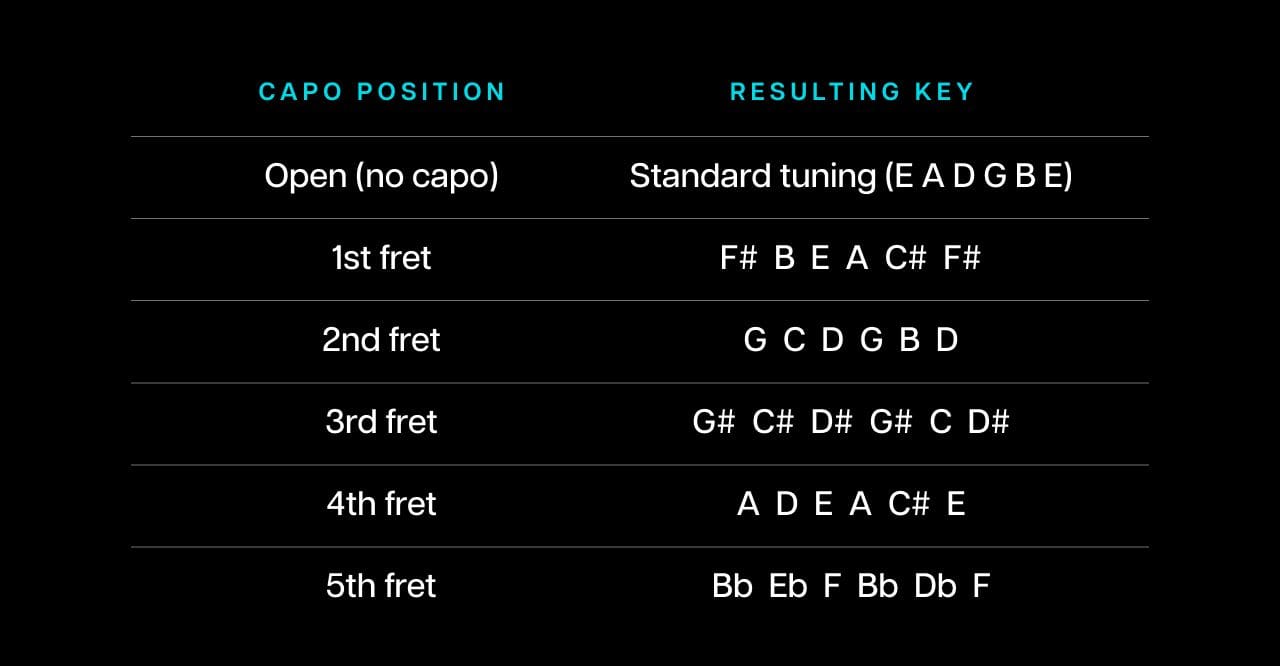
When using a capo, avoid common mistakes that can impact your guitar’s sound and longevity. Sliding the capo up or down the fretboard without lifting it can damage the strings and fretboard. Instead, gently remove and reposition it when changing frets.
Also, be careful not to apply excessive pressure. Too much tension can strain the strings and affect your guitar’s neck, leading to tuning issues and potential damage. Aim for a balance: the capo should hold the strings firmly, but not too tightly. This ensures clear, in-tune notes while preserving the instrument’s condition.
Creative uses for guitar capos
A guitar capo is more than just a tool for simplifying chord shapes. It’s also a gateway to creative exploration, offering new sounds, playing techniques, and musical styles to discover.
Experimenting with alternate tunings
While a capo is commonly used to change the key of a song, it’s also a great tool for experimenting with alternate tunings without the need to retune your entire guitar.
For instance, if you want to explore open D tuning, simply place the capo on the second fret while your guitar is still in standard tuning. This allows you to play familiar chord shapes while achieving the resonant, open sound of an alternate tuning.
Using a capo for fingerstyle guitar
A capo, especially a partial capo that only covers select strings, can add a unique dimension to fingerstyle guitar playing. By focusing on specific strings, a partial capo enables you to create distinctive sounds, such as drone notes or altered bass lines, while keeping the other strings in standard tuning.
This approach allows for creating intricate musical textures and detailed melodies, adding depth and expression to your fingerstyle pieces. Experimenting with different capo placements can lead to unique chord voicings and inspire fresh musical ideas.
Capo Mode: A guitar capo feature by Moises
Capo Mode is a Moises feature that allows you to change the displayed chord shapes to match different capo positions while keeping the song’s original pitch. This makes it easier, for example, to play songs with complex chords without altering the key or tuning of the music.
Some highlights of Capo Mode are:
- Simplified chords: Play challenging songs with ease by using simplified chord shapes without altering the original pitch;
- Creative exploration: You can experiment with different capo positions to discover unique tonal landscapes and chord voicings;
- Seamless practice: Capo Mode can be integrated into your routine for smoother, more efficient practice sessions;
- Versatility: This feature is tailored to suit both beginners and advanced players, adapting to your musical needs;
- Confidence boost: Focus on playing without the stress of complex transitions, allowing you to perform with greater assurance.
Just like a guitar capo, Capo Mode lets you explore music in new ways, enhancing your playing experience. By simplifying complex chord progressions, it encourages experimentation and further development of your skills.
